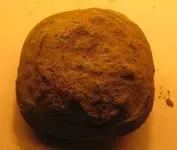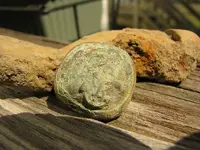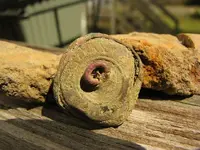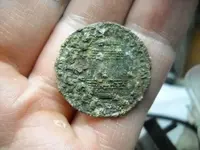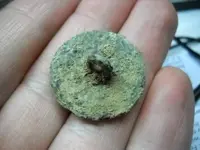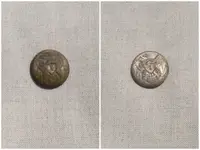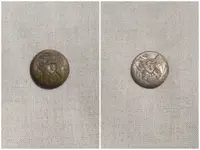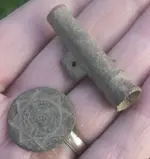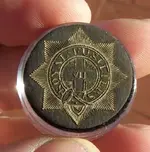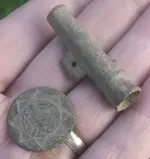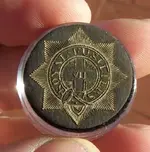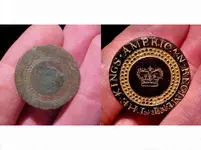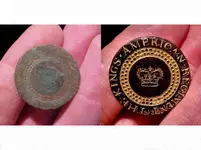Jason H. said:
Many thanks for this thread, BuckleBoy!
Last weekend, I was digging several feet down into the foundation of a 1700s structure that apparently burned many years ago. Pipe bowls, glass, oysters, etc. were showing up, along with this button. It seems to be a pewter button and has a design on it I'm not familiar with- looks like a barrel? I'd like to clean it so I can read more of the lettering and get an ID on it, but as you can see there are already small cracks so I must be careful. What's the best way to clean this pewter button?
Thanks for any help!
-Jason
Now that is a tough one!
Here's what I would do, and you really have to think about how you go about it because there's so little that can be done with that button.
The first thing I'd do is get some water-based clean urethane/lacquer and a small paint brush and coat the back, give it a quick wipe with a lint free cloth, then let dry. I would also seal the sides the same way, as well as the outer edge of the front where the cracks are... but leave the majority of the face alone. That button doesn't look like it's going to last too long being cracked like that.
For stage 2 I would soak it in olive oil just the same way people have done for copper coins for years. I no longer put my coins in oil, but learned something many years ago not knowing any better and throwing a pewter button in, and that is it cleaned it! It took many months, and I left it in a little too long and the edge got eaten down to the base metal, but had I checked on it once a month I probably could have avoided the cleaning going too far.
Stage 3... and the unknown territory. I told you to seal the button first because it does need it, but also because olive oil does not seem to prevent further decay, something that surprised me. Now here's what I can't tell you because I've never actually tried it... will the acid in the oil eat the urethane off the button leaving it unprotected? It's not really a big deal if it does as it just puts you back to where you are now, but it makes a long soak a little more concerning and cracking/edge loss more possible.
Anyway, good luck. What I suggested is sort of a safe way to try and clean it because pewter is tough in general, and you really don't want to be aggressive in any way with that one. Many people would tell you to seal it as is and be happy with it, but I would be determined to see more detail, and after reading my suggestion it's probably obvious I didn't just wake up today and came up with that. I have cleaned one heck of a lot of buttons for quite a few years now, but even so I still have never come up with a great way to clean pewter to keep it looking old. Some people buff the corrosion off, but I don't care for that, and with so much cracking I don't think it would be an option anyway.
There's no in between for that condition... it's either leave it as is, or clean it so it shines.




